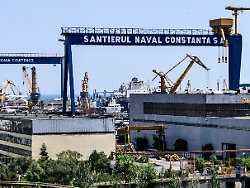difficulties in all ways
Ukrainian grain export overwhelms Romanians
6/18/2022 5:39 am
Romania is an alternative route for the transport of Ukrainian grain. However, as President Iohannis says, this remains a “logistical challenge of epic proportions”.
The Russian war of aggression in Ukraine has confronted neighboring EU country Romania with the difficult task of serving as an alternative route for the export of Ukrainian grain. Because of the inadequate transport infrastructure, Romania’s President Klaus Iohannis recently described this problem as a “logistical challenge of epic proportions”. Florin Goidea, general manager of the largest Romanian Black Sea port of Constanta, does not see a quick solution.
The transport routes from the Ukraine to Constanta alone are difficult. “More than 80 percent of incoming Ukrainian grain reaches our port on small cargo ships via the Danube,” says Goidea. The Danube Delta forms the Ukrainian-Romanian border in the southeast. These river freighters have to travel up the Danube from the Ukrainian Danube ports of Reni and Ismail – first on the meandering Chilia arm of the delta to Cernavoda inland and from there on the Danube-Black Sea Canal to Constanta, explains the port manager. That’s a good 320 kilometers from Ismail.
The way by truck is even more difficult: The trucks from the Ukraine sometimes have to wait for weeks at the border crossings because of the formalities. In the port of Constanta, on the other hand, the daily 20 to 25 incoming Ukrainian grain trucks cause crowds, as Goidea complains. Access by rail is as good as blocked because the Romanian state railway CFR parked 700 disused wagons at the port station – more than half of which have since been removed. 35 rail tracks at the port are now to be modernized for 200 million lei (40.8 million euros), said Transport Minister Sorin Grindeanu.
Plans for expansion but in early stages
There is a government project to expand and modernize the port, but this is only at the stage of planned feasibility studies, says Goidea. Among other things, it is about increasing the number of berths by 17 from the current 140 and making the harbor basin deeper in order to be able to admit larger ships. The port director estimates the cost to be between half a billion and one billion euros, and negotiations with the World Bank are under way about financing. The port administration also wants to apply for EU funds.
From the beginning of the Ukraine war until the beginning of June, 15 ships with a total of 242,000 tons of Ukrainian grain left Constanta, Goidea said. That would be just 1.21 percent of the 20 million tons of grain from last year’s harvest that Ukraine is currently planning to export. Throughout 2021, 25 million tons of grain from Romanian production and from neighboring countries were exported via Constanta. And the next harvest is just around the corner.
